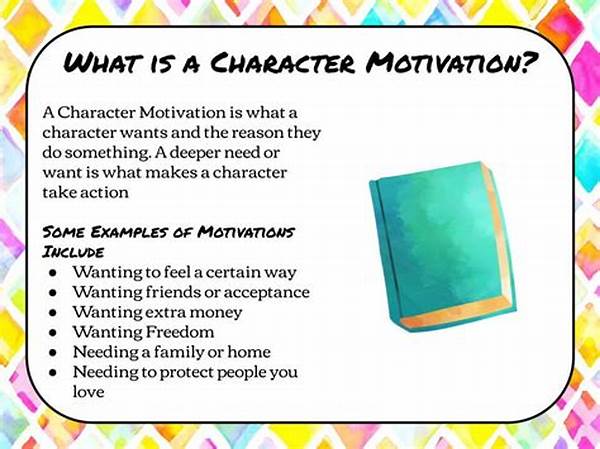Imagine yourself sitting by a warm fire, storytellers of old gathered around, weaving tales into the flickering shadows. Characters in these tales are not just mere figures; they breathe, dream, and are driven by motives as intricate as the constellations overhead. The essence of a compelling story lies in its characters’ motives, which unfurl like the petals of a mysterious flower, luring readers into the depths of their souls. As we embark on a journey through the art of developing complex character motives, we will unlock the mysteries of human desires and fears that propel a narrative forward, edging it ever closer to the heart of the audience.
Read Now : Cultivating Reader Relationships With Newsletters
The Art of Crafting Intricate Motives
Deep within every narrative, the art of developing complex character motives acts as a storyteller’s secret ingredient. Each character’s motivation is a tapestry of experiences, desires, and fears that binds them to the narrative’s unfolding drama. Imagine a character whose desire for power stems from a childhood of neglect, where every slight fueled their resolve to never be vulnerable again. Picture another, haunted by guilt, whose every action is a penance to resurrect the past. These motives, layered and complex, weave a rich texture into the narrative, inviting the reader on a journey through the labyrinth of a character’s psyche.
Creating such motives is akin to sculpting from a block of stone. Every chisel mark is a detail uncovered, revealing the character’s innermost desires. It demands patience and a keen observation of life’s intricacies. Consider a protagonist who forsakes wealth, driven by the intangible pursuit of knowledge and truth. Their journey becomes less about the destination and more about understanding the riddle of their own heart. As writers, by developing complex character motives, we construct a bridge between the character and the reader, a passage paved with empathy, curiosity, and the universal language of human experience.
Unraveling Layers of Motives
1. Echoes of the Past: In storytelling, characters often carry echoes of their past, where every scar tells a silent tale. Developing complex character motives begins by exploring these shadows, inviting the audience to decipher the whispers of old wounds.
2. Desires Unseen: Characters are more than their actions. By developing complex character motives, storytellers lay bare the subtle yet powerful desires that characters themselves might not fully comprehend.
3. Conflict and Tension: At the heart of any narrative is conflict, a byproduct of developing complex character motives. Opposing desires within a character create tension, driving the story toward dramatic crescendos.
4. Empathy Creation: When characters are driven by well-crafted motives, readers find a mirror reflecting their own struggles. Developing complex character motives fosters empathy, entwining the audience emotionally with the narrative’s pulse.
5. Journey of Discovery: Every motive presents a journey. Through developing complex character motives, writers invite the audience to partake in the character’s discovery, revealing truths about the human condition.
The Psychological Depth in Fiction
Embarking on the journey of developing complex character motives is akin to diving into the wellspring of human psychology. It involves dissecting layers of emotions, desires, and fears, unraveling the intrinsic threads that catalyze a character’s every decision. Each layer, whether driven by love, revenge, or redemption, is a compelling force that reshapes the narrative landscape, offering new vistas for the reader to explore.
Read Now : Manipulating Reader Emotions In Horror
Characters traverse a spectrum of motivation, from Abraham Lincoln’s passionate pursuit of justice to Jay Gatsby’s tragic yearning for lost love. By developing these complex character motives, authors are given the profound power to guide their audience through the darkness and light of human ambition. It’s within this intricate dance between motive and action that readers find the allure of storytelling, captivated by the unpredictable yet deeply relatable journey of discovery and transformation.
Building a Motive Foundation
Laying the foundation for developing complex character motives is analogous to planting a seed that will one day burgeon into a towering tree. Each motive must be rooted deeply in the soil of the character’s lived experiences, beliefs, and intrinsic desires, pulling nutrients from every aspect of their imagined lives. As storytellers, the narrative we craft becomes the environment that nourishes and challenges growth, coaxing the character’s motives into full bloom under the reader’s gaze.
Nurturing Character Motives in Narrative
The narrative world offers limitless opportunities for developing complex character motives that resonate deeply with readers. As characters embark on quests dictated by their inner desires, each interaction and choice becomes charged with significance, guiding readers to reflect on their own motivations. Through their personal journeys, characters embody the struggles, victories, and reconciliations that underscore the human experience.
In nurturing these motives, storytellers sow seeds of empathy, fostering a connection that transcends the written word. Readers become not just passive observers but active participants in a shared exploration of the universal themes of ambition, duty, love, and loss. This narrative symbiosis enriches both the reader’s understanding of the character and their enlightenment of the self, beautifully threading stories into the fabric of lived experience.
Intimate Environments to Explore Motives
Creating vivid environments where developing complex character motives can thrive is a crucial strand in the storytelling tapestry. Enriching the narrative with intimate settings invites a deeper understanding of characters and the forces driving them. Picture an old library filled with silent echoes, a preferred haven for a character wrestling with knowledge and self-doubt. Such environments serve as reflections of internal conflicts, illuminating the complicated motives at play.
In these settings, the external world becomes a character in itself, a catalyst that challenges, comforts, and transforms. Just as a storm may mirror a character’s inner turmoil, a serene landscape might offer solace and clarity. Through carefully crafted environments, storytellers communicate layers of meaning, offering nuanced insights into the intricate dance of motives that define each character’s journey.









